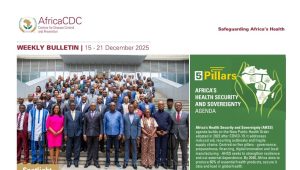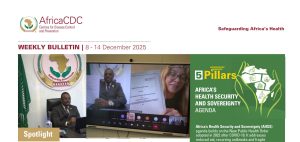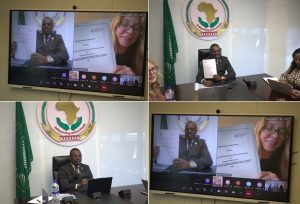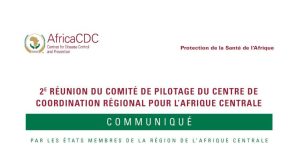In a small rural clinic in Africa, a mother cradles her feverish child as a doctor delivers a troubling prognosis: the antibiotics aren’t working. The bacteria causing the infection appears to have become resistant. Once unimaginable, this reality underscores the growing threat of antimicrobial resistance (AMR), now a silent but formidable health crisis across Africa.
For decades, antibiotics have been a cornerstone of modern medicine, saving millions of lives. However, their misuse and overuse in human health, agriculture and livestock have led to the development of resistant microorganisms. In 2019, AMR caused an estimated 23.7 deaths per 100,000 people in Africa, surpassing the combined death toll of HIV-AIDS, tuberculosis and malaria. AMR is not just a health challenge—it threatens food security, economies and livelihoods across the continent.
The Scale of the AMR Challenge
Africa faces significant challenges in combating AMR, driven by weak laboratory capacity, limited surveillance and systemic gaps that allow resistant microorganisms to thrive. Poor hygiene, counterfeit antibiotics, insufficient infection control and weak health systems exacerbate the crisis, undermining efforts to implement effective policies.
Only 16% of 37 countries conduct routine AMR surveillance in animals, despite evidence of resistant bacteria on animal farms. Africa CDC’s MAAP study revealed that just 1.3% of microbiology labs in 14 member states could test for key AMR pathogens, exposing a critical lack of diagnostic capacity. This gap delays timely responses and underscores the urgent need for investment in National Action Plans (NAPs).
A Lancet study further highlighted deficiencies, showing that only 1% of 53,770 labs in 14 countries could perform bacterial testing, leaving over 136 million people without access to antimicrobial susceptibility testing (AST). The study also revealed that only 23% of labs met ISO15189 accreditation standards, and automated diagnostic tools were scarce, reflecting inadequate infrastructure and quality systems.
Higher-tier and private not-for-profit laboratories performed better than government facilities, but NAPs allocated less than 20% of resources to addressing these deficiencies. To combat AMR effectively, experts recommend scaling bacterial testing to reach 80% of the population, decentralising services, improving lab accreditation, and integrating electronic data systems with sentinel site networks for robust surveillance.
Strengthening laboratory systems is crucial to containing AMR, enabling timely interventions, and protecting public health. Urgent investment and coordinated action are vital to overcoming this escalating threat.
Africa’s Response: Strengthening Systems and Capacities
Recognising the severity of the crisis, Africa CDC has continued to support African member states in national and regional efforts to strengthen AMR surveillance. Our Africa Pathogen Genomics Initiative (PGI), launched during the COVID-19 pandemic, equips countries with the tools to track and combat AMR. We are fostering collaborations and partnerships to strengthen laboratory diagnostics, microbiology, and genomic surveillance capacity for AMR across Africa. These efforts are needed to enable real-time tracking of AMR patterns and offer critical data for timely interventions.
In addition to technical innovations, Africa CDC is building human capacity. Advanced training for scientists is creating a skilled workforce capable of conducting high-quality research, surveillance and response activities. This comprehensive approach ensures that African countries are better prepared to tackle AMR and other health threats.
Global Commitments and Support
The year 2024 is significant in global strides on AMR, giving AMR the urgent attention required. In September, the 2nd High-Level Meeting on AMR – held on the margins of the 79th United Nations General Assembly – adopted a political declaration to reduce AMR deaths by 10% by 2030. Backed by $100 million in catalytic funding, the declaration sets ambitious targets, including universal access to water, sanitation and hygiene (WASH) in healthcare facilities, adherence to WHO infection prevention standards, and reducing the misuse of antibiotics in agriculture.
Building on this momentum, the 4th Global High-Level Ministerial Conference on AMR in Saudi Arabia introduced the Jeddah Commitments, focusing on sustainable financing, formalised accountability, and equitable access to antimicrobials. Saudi Arabia also announced the establishment of an AMR One Health Learning Hub and a Regional AMR Access and Logistics Hub, both to be based in the Kingdom. Additionally, the conference formalised the Global High-Level Ministerial Conferences on AMR as a biennial event, with the next conference scheduled for 2026.
Simple Solutions with Significant Impact
While these conversations aim for ambitious targets requiring substantial financial investment, there are simple measures that can yield significant benefits. For example, improving WASH and infection prevention in healthcare facilities could avert up to 20% of AMR-related deaths annually in Africa. These interventions are cost-effective and essential for reducing the spread of resistant microorganisms.
In the Continental Landmark Report, African Member states clearly articulate recommendations for a unique opportunity for Africa to elevate its priorities and secure commitments towards addressing AMR. Africa CDC led the political advocacy for African priorities, and the secured commitments will enable Africa to enhance
its capacity to address AMR and more effectively contribute to the global response.
Case Study: Malawi’s Comprehensive Approach
Countries in Africa are making progress in tackling AMR, and Malawi’s experience offers some best practices for addressing this threat. Its AMR Coordinating Committee (AMRCC), established within the Ministry of Health, exemplifies a One Health approach that integrates human, animal and environmental health sectors. Supported by strong legislative frameworks and political commitment, the Malawi AMRCC prioritises surveillance, rational antimicrobial use and infection control.
Malawi’s success stems from its holistic strategy, which includes continuous training for healthcare workers, robust monitoring systems, and effective stakeholder engagement. This approach not only addresses AMR but also strengthens the country’s overall health systems. Malawi demonstrates how strong leadership and collaboration can yield tangible results in the fight against AMR.
A Call to Action
Antimicrobial resistance is one of the greatest health crises of our time, threatening to erase decades of progress in global health. However, with strong leadership, strategic investments and global collaboration, Africa can turn the tide.
Malawi’s success demonstrates the transformative impact of unified efforts. By prioritising infrastructure, capacity building and interventions such as WASH, the continent can protect its people and sustain its progress.
The stakes are high, but the solutions are clear. Through collective action and unwavering commitment, we can combat AMR and secure a healthier, more resilient future for Africa and the world.







